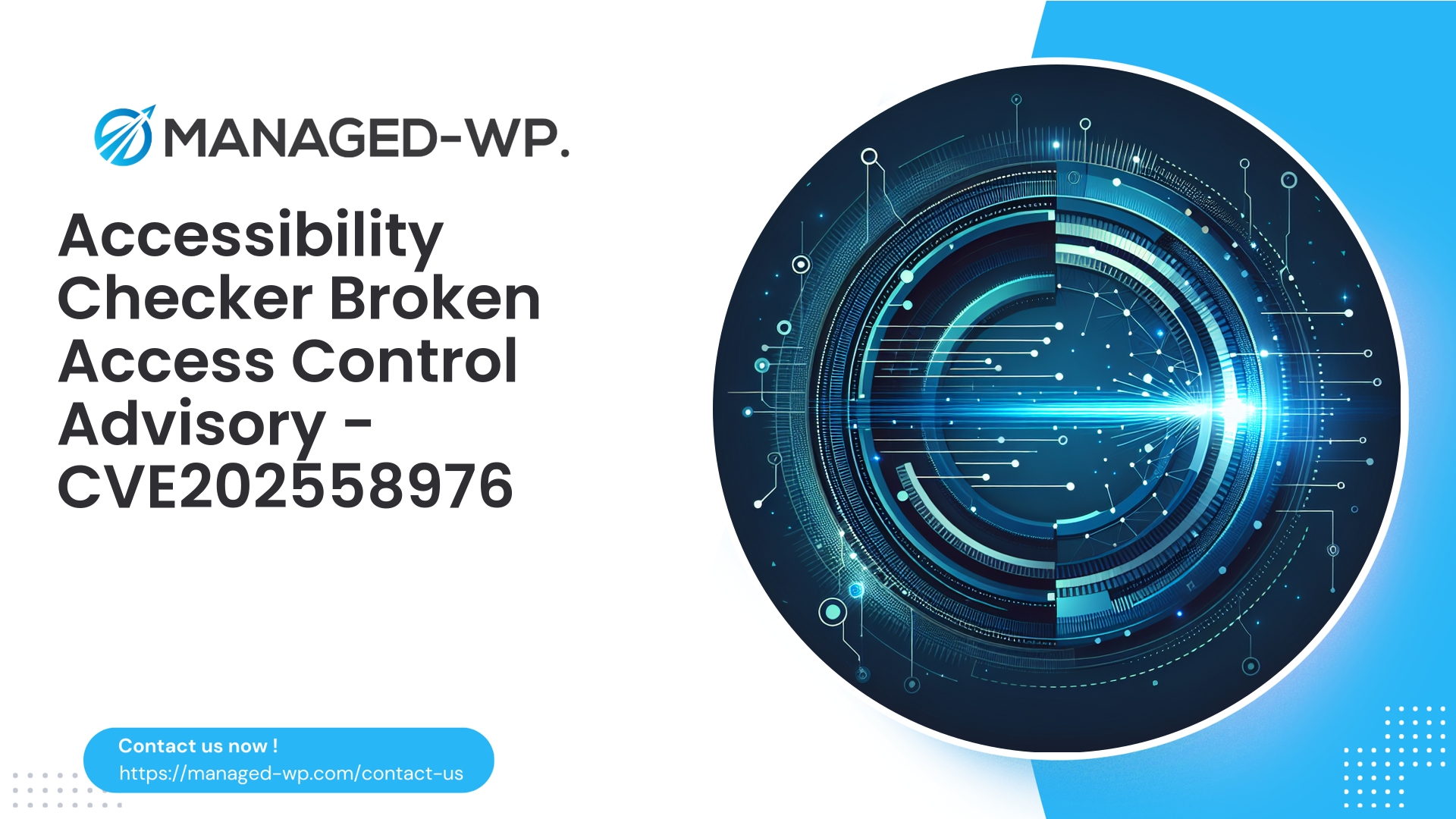| 插件名称 | 导师学习管理系统 |
|---|---|
| 漏洞类型 | SQL 注入 |
| CVE编号 | CVE-2025-58993 |
| 紧急 | 低的 |
| CVE 发布日期 | 2025-09-09 |
| 源网址 | CVE-2025-58993 |
Tutor LMS(≤ 3.7.4)SQL注入漏洞(CVE-2025-58993):WordPress网站运营者的战略警报
作者: 托管式 WordPress 安全专家
发布日期: 2025-09-10
标签: WordPress、安全、导师学习管理系统 (LMS)、SQL 注入、Web 应用防火墙 (WAF)、补丁管理
执行摘要
一个被识别为 CVE-2025-58993 的重大 SQL 注入漏洞会影响 Tutor LMS 插件 3.7.4 及更早版本。该漏洞的 CVSS 评分为 7.6,由安全研究员 YC_Infosec 负责任地披露,并在 Tutor LMS 3.8.0 版本中得到修复。
使用 Tutor LMS 的网站管理员应立即采取以下措施:
- 请立即将 Tutor LMS 升级到 3.8.0 或更高版本。
- 如果暂时无法进行更新,则实施严格的管理访问限制,启用强大的 Web 应用程序防火墙 (WAF),并加强网站的整体安全防护。
- 密切监控日志,留意可疑活动,并对网站进行全面扫描,以检测任何安全漏洞。鉴于此漏洞的性质,务必极其重视数据保密风险。
这份详细的简报涵盖了针对 WordPress 环境的技术方面、利用风险、缓解策略、WAF 规则建议和事件响应协议。
背景信息
- 漏洞类型: SQL 注入
- 受影响的软件: Tutor LMS WordPress 插件
- 易受攻击的版本: 3.7.4 及更早版本
- 已修复: 版本 3.8.0
- CVE 参考编号: CVE-2025-58993
- 信息披露时间表: 报告日期:2025年8月15日;公开披露日期:2025年9月9日
- 补丁建议: 应用 3.8.0 版本或执行补偿控制
分析表明,此漏洞源于插件中输入清理不足和不安全的 SQL 查询构造。虽然没有提供具体的概念验证细节,但 SQL 注入漏洞通常允许攻击者在处理不可信输入时篡改数据库查询。
WordPress 环境中 SQL 注入的严重性
SQL注入仍然是最危险的攻击类型之一,它允许攻击者未经授权广泛访问后端数据库。潜在影响包括:
- 提取个人身份信息(PII),例如用户电子邮件和其他敏感字段。
- 提升或创建管理账户,损害网站完整性。
- 出于恶意目的(包括网络钓鱼和搜索引擎优化垃圾邮件)更改网站内容或选项。
- 完全窃取数据库数据,从而促进进一步的横向移动或权限提升。
- 在某些配置中,可以通过数据库函数执行任意命令。
虽然初始利用可能需要管理员权限,但实际存在的威胁途径包括网络钓鱼导致的凭证泄露和 CSRF 攻击,这些攻击可以绕过常规限制。一旦漏洞被公开,预计会迅速出现自动化利用尝试。
Managed-WP 强烈建议将此漏洞视为高风险漏洞,直到有证据表明并非如此为止。
立即采取的行动(24-72小时内)
- 请将 Tutor LMS 更新至 3.8.0 或更高版本
– 本次更新解决了根本原因,彻底缓解了漏洞。
– 更新之前务必执行备份操作,并尽可能在测试环境中测试更改。 - 如果无法立即更新,则限制访问
– 使用 IP 允许列表或防火墙规则限制 wp-admin 访问权限。
– 强制所有管理员用户使用强密码和唯一密码,并启用多因素身份验证 (MFA)。
– 如果情况紧急,请考虑暂时禁用 Tutor LMS。 - 确保 WAF 保护已激活
– 激活或验证您网站的 WAF,例如 Managed-WP WAF 或同等产品。
– 部署针对此 SQLi 攻击向量的自定义或推荐虚拟修补规则。
– 持续监控 WAF 日志以检测异常。 - 审计管理权限
检查所有管理员帐户是否存在可疑活动。
– 在适当情况下强制注销和重置密码。 - 立即备份您的网站
– 创建完整备份(文件和数据库),并安全地离线存储。
– 使用这些备份进行事件取证和快速恢复。 - 进行安全扫描
– 扫描恶意软件和完整性问题,以检测入侵迹象。
检查是否存在异常文件或未经授权的更改。
推荐的WAF虚拟修补策略
以下建议提供了一些切实可行的启发式方法,以降低插件更新前的风险。我们强调在生产环境部署前进行严格的测试,以避免误报。
1. 阻止请求参数中的 SQL 注入签名
- 针对典型的 SQL 注入攻击,例如:
联合选择,SELECT ... FROM,信息模式,LOAD_FILE(,写入输出文件,基准(,睡觉(以及类似这样的 MySQL 注释技巧/*! ... */.
如果请求体包含正则表达式 (?i)(union\s+select|select\s+.*\s+from|information_schema|load_file\(|into\s+outfile|benchmark\(|sleep\(|/\*!\d+)),则阻止该请求。
2. 实施端点特定访问控制
- 识别 Tutor LMS AJAX 和 REST 端点(例如,/wp-admin/admin-ajax.php?action=tutor_*,/wp-json/tutor/)。
- 阻止未经验证的请求,并要求对 REST API 调用进行 nonce 验证。
- 采用限速措施以降低滥用风险。
3. 输入参数白名单
- 限制参数类型和格式,拒绝包含可疑字符或运算符的输入。
4. 内容类型验证
- 验证 multipart/form-data 或 JSON 输入有效负载的大小、格式正确性和内容模式,以检测嵌入式 SQL 有效负载。
5. 监控和警报
- 在短时间窗口内对多个触发区块实施警报(例如,10 分钟内触发 10 个区块)。
- 将日志汇总到中央平台,用于取证调查。
笔记: 这些虚拟补丁只是临时控制措施。要彻底解决问题,需要尽快应用厂商提供的补丁。
Tutor LMS 和 WordPress 的长期安全加固
- 遵循最小特权原则:
- 尽量减少管理员账户;在适用情况下分配权限范围角色。
- 限制数据库用户权限,仅允许执行操作绝对必要的权限。
- 强制执行强身份验证策略:
- 要求管理员和高级用户启用多因素身份验证 (MFA)。
- 实施严格的密码策略,防止密码重复使用和弱密码。
- 安全管理访问权限:
- 使用 IP 允许列表、反向代理或 HTTP 身份验证来保护 wp-admin 和登录门户。
- 考虑将关键管理界面移至额外的安全层之后。
- 安全配置管理:
- 通过受控的更新流程,保持 WordPress 核心、主题和插件始终为最新状态。
- 禁用仪表板中的文件编辑功能(
定义('DISALLOW_FILE_EDIT',true);). - 对 WordPress 进程应用严格的文件权限和服务器级权限。
- 日志记录和持续监控:
- 启用并保留访问权限、PHP 日志和 WAF 日志。
- 监控异常的数据库查询或管理操作激增情况。
- 备份和恢复:
- 维护经过测试的备份,并保留异地副本。
- 定期验证修复程序。
检测利用或定向攻击
- 审核日志: 仔细检查 WAF 和服务器日志,查找针对 Tutor LMS 端点的包含 SQLi 指标的请求。
- 数据库监控: 查找异常查询、导出或可疑的审计日志条目。
- 内容审核: 检查是否存在未经授权的管理员用户、意外的帖子修改或网站选项更改。
- 文件系统检查: 识别最近添加或修改的 PHP 文件,特别是那些经过混淆处理或使用了可疑函数的文件,例如
eval()或者base64_decode(). - 安全扫描: 使用信誉良好的恶意软件扫描器和文件完整性工具来检测恶意迹象。
疑似入侵事件响应检查清单
- 隔离: 如有必要,将网站置于维护模式或下线以减少损失;删除可访问的备份文件。
- 保存证据: 导出包含文件、数据库和服务器日志的取证快照,同时保留时间戳。
- 撤销和轮换凭证: 重置管理员密码,轮换 API 密钥,并使泄露的令牌失效。
- 消除持久性: 移除后门、未经授权的管理员帐户和可疑的计划任务。
- 恢复清洁状态: 从已知的干净备份中恢复,更新插件和主题,并重新应用安全加固措施。
- 通知利益相关者: 根据相关政策法规通知主机提供商和受影响的用户。
- 事件后回顾: 进行根本原因分析,并根据吸取的经验教训改进应对方案。
如果公司内部专业知识有限,我们强烈建议您聘请专业的安防公司来协助您。
为什么Web应用程序防火墙和虚拟补丁至关重要
WAF 在漏洞披露和补丁部署之间的这段时间内发挥着至关重要的保护屏障作用,其作用机制如下:
- 立即阻止已知的攻击模式,以减少风险。
- 通过详细的日志记录,提高对攻击尝试的可见性。
- 应用速率限制和基于启发式的检测方法来减缓自动化攻击。
- 允许虚拟修补,以保护无法及时更新的旧版或定制网站。
Managed-WP 提供专家主导的防火墙规则和持续支持,帮助您有效管理这些风险。
示例 ModSecurity 风格规则(供参考)
笔记: 务必先在非阻塞(仅日志)模式下测试规则,以防止干扰合法用户。
# 记录针对 Tutor LMS 的潜在 SQL 注入尝试 SecRule REQUEST_URI "@rx /wp-admin/.*|/wp-json/.*tutor.*|admin-ajax.php" \ "phase:2,log,pass,id:1009001,msg:'可能对 Tutor 插件发起 SQL 注入尝试',severity:2,chain" SecRule ARGS|REQUEST_BODY|REQUEST_HEADERS "@rx (?i:(union\s+select|select\s+.*\s+from|information_schema|load_file\(|into\s+outfile|benchmark\(|sleep\(|/\*!\d+|--\s))" \ "t:none,t:urlDecode,t:lowercase,logdata:'匹配的数据:' %{MATCHED_VAR}',capture,ctl:ruleRemoveById=981248,tag:'SQLI',deny,status:403"
此规则针对访问管理或与导师相关的 REST 端点的请求,并在确认后阻止包含 SQLi 签名模式的请求。
攻击者可能通过此漏洞实现的目标
- 窃取学生数据、课程详情以及可能的支付信息。
- 获取或提升权限以维持未经授权的访问。
- 插入恶意内容,例如恶意软件或网络钓鱼程序。
- 建立长期访问的后门。
鉴于教育数据的敏感性,各组织必须高度重视隐私和合规要求,谨慎对待此类数据泄露。
针对插件开发者和网站管理员的战略建议
致插件开发者:
- 始终采用参数化查询和清理 API 来防止注入攻击。
- 避免使用未经清理的输入进行动态 SQL 程序集编写。
- 对管理端点实施严格的能力检查和随机数验证。
- 在发布前开发单元测试和模糊测试,以识别注入漏洞。
致网站运营者:
- 部署前,应维护隔离的测试环境,以便进行全面测试。
- 订阅漏洞通知源并定期更新WAF签名。
- 定期审核已安装的插件,以停用或替换不受支持的代码。
- 建立符合安全最佳实践的插件审批和审查政策。
常见问题解答
问:如果我不使用Tutor LMS,我会有风险吗?
答:此漏洞仅针对 Tutor LMS 3.7.4 及更早版本。但是,许多插件都存在漏洞风险;对于所有 WordPress 网站而言,保持软件更新至关重要。
问:该漏洞利用需要管理员权限。这是否会降低其紧迫性?
答:完全不是这样。管理员凭证经常会通过网络钓鱼或其他攻击泄露。此外,插件端点也可能因 CSRF 或链式漏洞而暴露。必须立即采取行动。
问:升级到 3.8.0 版本后,是否还需要采取其他措施?
答:确认插件功能正常,清除相关缓存,监控日志是否存在异常,并据此调整WAF规则。持续保持警惕至关重要。
问:WAF 可以取代补丁吗?
答:不。Web应用防火墙(WAF)可以降低风险,但并不能消除根本漏洞。更新插件才是最终的解决方案;WAF 只是一种必要的临时安全措施。
时间线概览
- 2025 年 8 月 15 日 – YC_Infosec 报告的漏洞。
- 2025 年 9 月 9 日 – 公开披露和 CVE 分配 (CVE-2025-58993,CVSS 7.6)。
- 2025 年 9 月(待定)——Tutor LMS 3.8.0 版本发布补丁;建议立即更新。
Managed-WP 如何为您提供支持
Managed-WP 提供全面的 WordPress 安全平台,包括:
- 管理防火墙规则和快速虚拟补丁,以防止攻击。
- 恶意软件扫描、自动清理和完整性监控。
- 实时记录和警报,以保持对局势的了解。
- 安全咨询、事件响应指导和持续支持。
我们的团队已准备好协助实施自定义规则和进行事后恢复。
立即保护您的网站——开始使用 Managed-WP Basic(免费)
使用 Managed-WP Basic 快速保护您的 WordPress 网站——免费,零承诺。
在此注册: https://my.wp-firewall.com/buy/wp-firewall-free-plan/
功能包括:
- 提供托管防火墙保护,包括 WAF 和处理 OWASP Top 10 威胁。
- 无限带宽,持续进行恶意软件扫描。
- 升级选项包括自动清理和高级安全控制。
立即通过简单的部署开始保护您的网站,并在准备好增强安全层时进行扩展。
结论:行动迅速,计划周全
Tutor LMS SQL 注入漏洞对 WordPress 网站的安全性和数据完整性构成重大威胁。尤其需要注意的是:
- 请立即优先将 Tutor LMS 更新至 3.8.0 或更高版本。
- 如果更新暂时延迟,请使用管理锁定、多因素身份验证 (MFA) 和 Web 应用身份验证 (WAF) 规则。
- 持续检查您的环境是否存在攻击迹象,并做好迅速应对的准备。
安全需要多层次的应对措施;仅仅打补丁是必要的,但远远不够。检测、遏制和恢复措施能够显著降低安全事件发生时的损失。
如果您需要专家支持或 WAF 规则评估,Managed-WP 的安全团队随时准备为您提供帮助。
注意安全。
托管式 WordPress 安全专家



















